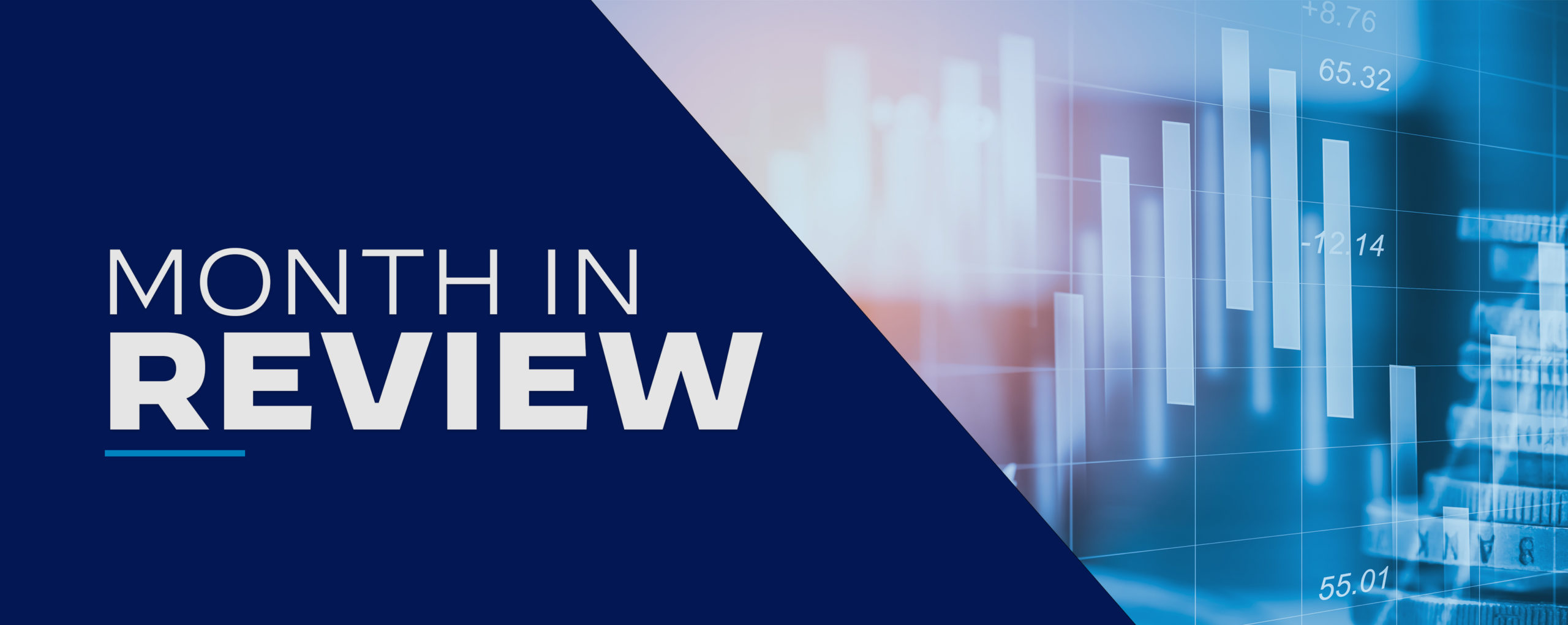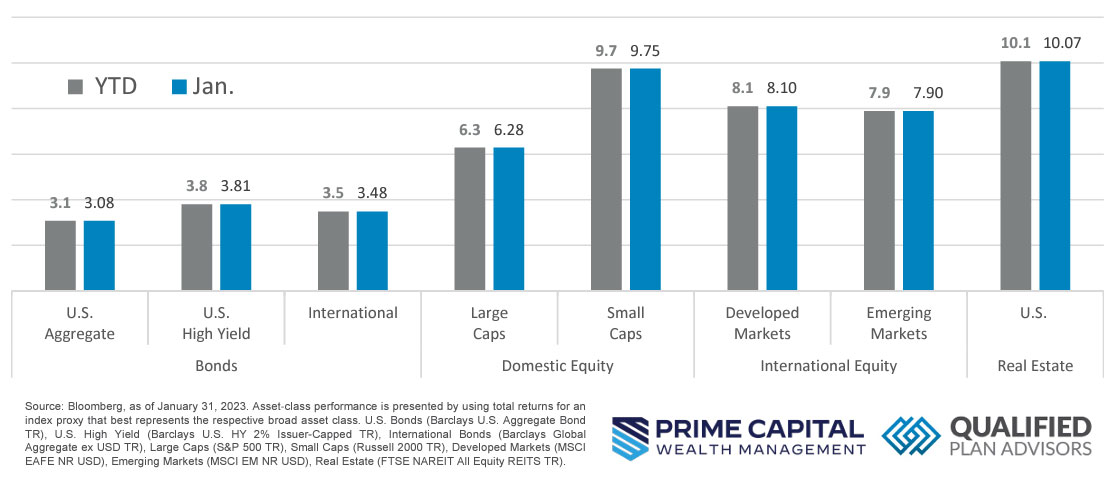Quick Takes
- Risk Assets Catch a Bid. Risk assets started the new year with a strong month with almost all major asset classes posting solid performance for the month of January.
- GDP Was Up Despite The Fed. After the Fed spent the majority of the last year in a dramatic campaign of tightening monetary policy to reduce rampant inflation, the US Economy remained resilient with GDP growth for the final quarter of 2022 landing well above consensus expectations of +2.6%, coming in at +2.9%.
- Greenback Stumbles. With recent economic data suggesting that the Fed might be on the right path to taming inflation and keeping the economy afloat, market participants are seeing a path to the Fed pausing interest rate hikes, which has led to the dollar steadily declining into the start of the year.
- Labor Markets and Inflation. While market participants cheered on the solid data readings regarding GDP, some areas of the economy are flashing warning signs with wage growth continuing to slow and consumer spending hinting at curbing demand for goods and services. While this could be good for inflation, it might be bad news for continued positive GDP growth in the future.
Asset Class Performance
After 2022’s dismal market performance across almost all major risk assets, 2023 has started off with reversing that trend with almost all major risk asset classes healthily in the green. Domestic Real Estate and Small Caps were some of the leaders for the month of January, but International and Emerging Equity markets were hot on their heels.
Markets & Macroeconomics
Much to market participants’ surprise, initial GDP numbers for the final quarter of 2022 came in healthily above expectations of +2.6%, landing at +2.9%. This surprise in the data reading comes on the back of one of the most extreme monetary tightening campaigns in history enacted by the Federal Reserve throughout 2022. With the Fed increasing interest rates to slow down the economy and thus tame rampant inflation, the economy’s resiliency to continue growing is a sign that the Fed is moving in the right direction to tame inflation while not sending the US economy into a sustained recessionary period. While the headline GDP numbers are encouraging, when digging into the underlying data there are still some areas where warning signs are flashing. As illustrated in the lower portion of the chart above, Consumer Spending came in below the previous quarter at +2.1%. This highlights that consumers are feeling the effects of runaway inflation and have been curbing back spending throughout much of last year. This data comes paints a mixed picture, where less consumer demand is helpful for the narrative of reducing the rate of increasing inflation but if consumer spending drops by too much for too long, this could send the economy into a recessionary period. While the Fed has tools in the toolbox to combat a contraction in economic growth, their willingness to utilize these tools, i.e., cutting interest rates or quantitative easing, will be largely dependent on where inflation, employment, and goods and services demand data levels are at, and possibly more important the trends that those data points are exhibiting if that scenario begins to play out.
Bottom Line: The US Economy ended last year on the right foot with GDP numbers coming out higher than expected for the final quarter of the year. This could hint that the Fed is on track to tame inflation while not sending the economy into a recession but some of the underlying data is leading market participants to believe that we are not out of the woods yet and that the risk of the Fed overtightening monetary policy is still on the table. The Fed’s narrative has led many market participants to believe that even if the Fed sends the US Economy into a recession and inflation has not reached the Fed’s desired level, they will keep monetary conditions tight to prioritize taming inflation over economic growth.
Download the full review.
©2022 Prime Capital Investment Advisors, LLC. The views and information contained herein are (1) for informational purposes only, (2) are not to be taken as a recommendation to buy or sell any investment, and (3) should not be construed or acted upon as individualized investment advice. The information contained herein was obtained from sources we believe to be reliable but is not guaranteed as to its accuracy or completeness. Investing involves risk. Investors should be prepared to bear loss, including total loss of principal. Diversification does not guarantee investment returns and does not eliminate the risk of loss. Past performance is no guarantee of comparable future results.
Source: Bloomberg. Asset‐class performance is presented by using market returns from an exchange‐traded fund (ETF) proxy that best represents its respective broad asset class. Returns shown are net of fund fees for and do not necessarily represent performance of specific mutual funds and/or exchange-traded funds recommended by the Prime Capital Investment Advisors. The performance of those funds June be substantially different than the performance of the broad asset classes and to proxy ETFs represented here. U.S. Bonds (iShares Core U.S. Aggregate Bond ETF); High‐Yield Bond (iShares iBoxx $ High Yield Corporate Bond ETF); Intl Bonds (SPDR® Bloomberg Barclays International Corporate Bond ETF); Large Growth (iShares Russell 1000 Growth ETF); Large Value (iShares Russell 1000 Value ETF); Mid Growth (iShares Russell Mid-Cap Growth ETF); Mid Value (iShares Russell Mid-Cap Value ETF); Small Growth (iShares Russell 2000 Growth ETF); Small Value (iShares Russell 2000 Value ETF); Intl Equity (iShares MSCI EAFE ETF); Emg Markets (iShares MSCI Emerging Markets ETF); and Real Estate (iShares U.S. Real Estate ETF). The return displayed as “Allocation” is a weighted average of the ETF proxies shown as represented by: 30% U.S. Bonds, 5% International Bonds, 5% High Yield Bonds, 10% Large Growth, 10% Large Value, 4% Mid Growth, 4% Mid Value, 2% Small Growth, 2% Small Value, 18% International Stock, 7% Emerging Markets, 3% Real Estate.
Advisory products and services offered by Investment Adviser Representatives through Prime Capital Investment Advisors, LLC (“PCIA”), a federally registered investment adviser. PCIA: 6201 College Blvd., Suite#150, Overland Park, KS 66211. PCIA doing business as Prime Capital Wealth Management (“PCWM”) and Qualified Plan Advisors (“QPA”). Securities offered by Registered Representatives through Private Client Services, Member FINRA/SIPC. PCIA and Private Client Services are separate entities and are not affiliated.
© 2022 Prime Capital Investment Advisors, 6201 College Blvd., Suite #150, Overland Park, KS 66211.
- Alphabet stock pullback a buying opportunity - July 25, 2024
- Prime Capital Investment Advisors Welcomes James Burton as Independent Director of Advisory Board - July 15, 2024
- How Tax Planning Differs For Young Clients - July 15, 2024


